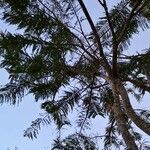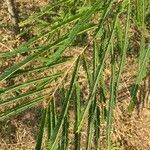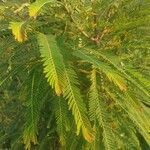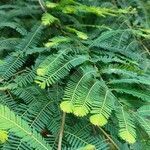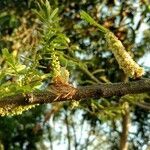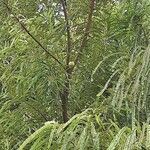| Therapeutic use
|
Abdominal pain (bark), Acne vulgaris (bark), Astringents (bark), Bronchitis (bark), Burns (bark), Cardiotonic agents (bark), Cholera (bark), Constipation (bark), Diarrhea (bark), Digestive system diseases (bark), Dysentery (bark), Furunculosis (bark), Gonorrhea (bark), Hemorrhage (bark), Insect bites and stings (bark), Jaundice (bark), Laxatives (bark), Myalgia (bark), Respiratory tract diseases (bark), Stomach diseases (bark), Stomatitis (bark), Vomiting (bark), Wounds and injuries (bark), Cooling effect on body (bark), Appetite stimulants (flower), Astringents (flower), Cardiotonic agents (flower), Digestive system diseases (flower), Flatulence (flower), Laxatives (flower), Respiratory tract diseases (flower), Cooling effect on body (flower), Abdominal pain (fruit), Abortifacient agents (fruit), Acne vulgaris (fruit), Hair loss (fruit), Analgesics (fruit), Anemia (fruit), Anorexia (fruit), Anti-bacterial agents (fruit), Antiemetics (fruit), Antifungal agents (fruit), Antimutagenic agents (fruit), Antineoplastic agents (fruit), Anti-obesity agents (fruit), Antioxidants (fruit), Antipyretics (fruit), Antirheumatic agents (fruit), Antithyroid agents (fruit), Antitoxins (fruit), Antiviral agents (fruit), Anuria (fruit), Anxiety disorders (fruit), Aphrodisiacs (fruit), Appetite stimulants (fruit), Asthenia (fruit), Asthma (fruit), Astringents (fruit), Atherosclerosis (fruit), Autoimmune diseases (fruit), Bites and stings (fruit), Blood pressure regulation (fruit), Brain diseases (fruit), Bronchitis (fruit), Cardiotonic agents (fruit), Cardiovascular agents (fruit), Cardiovascular diseases (fruit), Cataract (fruit), Cathartics (fruit), Central nervous system depressants (fruit), Chemoprevention (fruit), Chickenpox (fruit), Cholera (fruit), Colic (fruit), Common cold (fruit), Constipation (fruit), Coronary artery disease (fruit), Cough (fruit), Dandruff (fruit), Dental caries (fruit), Diabetes insipidus (fruit), Diabetes mellitus (fruit), Diarrhea (fruit), Digestive system diseases (fruit), Diuretics (fruit), Dysentery (fruit), Dyspepsia (fruit), Dysuria (fruit), Disorder of ejaculation (fruit), Emaciation (fruit), Endophthalmitis (fruit), Epistaxis (fruit), Erysipelas (fruit), Exanthema (fruit), Expectorants (fruit), Eye diseases (fruit), Eye pain (fruit), Fever (fruit), Flatulence (fruit), Gallstones (fruit), Gastric acid (fruit), Gastritis (fruit), Common cold (leaf), Gastrointestinal diseases (fruit), Gonorrhea (fruit), Graves ophthalmopathy (fruit), Hair diseases (fruit), Hair preparations (fruit), Headache (fruit), Heart diseases (fruit), Hematemesis (fruit), Hematologic diseases (fruit), Hemoglobins (fruit), Hemorrhage (fruit), Hemorrhoids (fruit), Hepatitis (fruit), Hepatitis, viral, human (fruit), Hepatomegaly (fruit), Hoarseness (fruit), Hypercholesterolemia (fruit), Hypertension (fruit), Hypoglycemic agents (fruit), Hypolipidemic agents (fruit), Hysteria (fruit), Immunomodulation (fruit), Infection (fruit), Inflammation (fruit), Insect repellents (fruit), Jaundice (fruit), Laxatives (fruit), Leprosy (fruit), Leukorrhea (fruit), Lice infestations (fruit), Liver injury (fruit), Liver diseases (fruit), Measles (fruit), Menorrhagia (fruit), Molluscacides (fruit), Mouth diseases (fruit), Myocardial infarction (fruit), Nausea (fruit), Nervous system diseases (fruit), Night blindness (fruit), Pain (fruit), Peptic ulcer (fruit), Pharyngitis (fruit), Polyuria (fruit), Pregnancy complications (fruit), Premature ejaculation (fruit), Radiation injuries (fruit), Radiation-protective agents (fruit), General tonic for rejuvenation (fruit), Respiratory tract diseases (fruit), Scabies (fruit), Scurvy (fruit), Skin diseases (fruit), Snake bites (fruit), Stomach diseases (fruit), Stomach neoplasms (fruit), Syphilis (fruit), Thirst (fruit), Ulcer (fruit), Urinary bladder calculi (fruit), Urinary bladder diseases (fruit), Urination disorders (fruit), Urogenital system (fruit), Vitiligo (fruit), Vomiting (fruit), Warts (fruit), Reduced salivation (fruit), Sexual debility (fruit), Cooling effect on body (fruit), Abdominal pain (leaf), Angiotensin-converting enzyme inhibitors (leaf), Anti-bacterial agents (leaf), Anticoagulants (leaf), Antifungal agents (leaf), Antinematodal agents (leaf), Aphrodisiacs (leaf), Appetite stimulants (leaf), Astringents (leaf), Bronchitis (leaf), Cardiotonic agents (leaf), Celiac disease (leaf), Conjunctivitis (leaf), Constipation (leaf), Dental caries (leaf), Diabetes mellitus (leaf), Diarrhea (leaf), Digestive system diseases (leaf), Dysentery (leaf), Dysentery, amebic (leaf), Dyspepsia (leaf), Endophthalmitis (leaf), Eye diseases (leaf), Eye infections (leaf), Fever (leaf), Flatulence (leaf), Hair diseases (leaf), Headache (leaf), Inflammation (leaf), Insect bites and stings (leaf), Insecticides (leaf), Laxatives (leaf), Mouthwashes (leaf), Oral ulcer (leaf), Pain (leaf), Periodontitis (leaf), General tonic for rejuvenation (leaf), Respiratory tract diseases (leaf), Scorpion stings (leaf), Stomach diseases (leaf), Ulcer (leaf), Urination disorders (leaf), Vitiligo (leaf), Vomiting (leaf), Wounds and injuries (leaf), Appetite stimulants (root), Astringents (root), Bronchitis (root), Cardiotonic agents (root), Constipation (root), Diarrhea (root), Digestive system diseases (root), Dysentery, amebic (root), Flatulence (root), Gastroschisis (root), Gonorrhea (root), Inflammation (root), Insect bites and stings (root), Jaundice (root), Laxatives (root), Myalgia (root), Pain (root), Anti-poisoning (root), Respiratory tract diseases (root), Stomatitis (root), Ulcer (root), Vitiligo (root), Coagulants (root), Cooling effect on body (root), Hair loss (seed), Aphrodisiacs (seed), Appetite stimulants (seed), Asthma (seed), Astringents (seed), Bronchitis (seed), Cardiotonic agents (seed), Diarrhea (seed), Digestive system diseases (seed), Dysentery (seed), Dyspepsia (seed), Endophthalmitis (seed), Epistaxis (seed), Eye diseases (seed), Fever (seed), Flatulence (seed), Laxatives (seed), Leukorrhea (seed), Menstruation disturbances (seed), Mental disorders (seed), Respiratory tract diseases (seed), Stomach diseases (seed), Syphilis (seed), Vomiting (seed), Diarrhea (shoot), Dyspepsia (shoot), Antidotes (stem), Dysuria (stem), Earache (stem), Insecticides (stem), Kidney diseases (stem), Snake bites (stem), Toothache (stem), Urination disorders (stem), Wounds and injuries (stem), Acrid (unspecified), Anemia (unspecified), Anodyne (unspecified), Anthrax (unspecified), Bactericide (unspecified), Candida (unspecified), Carbuncle (unspecified), Cholera (unspecified), Epilepsy (unspecified), Fever (unspecified), Fistula (unspecified), Gonorrhea (unspecified), Gravel (unspecified), Laxative (unspecified), Pimple (unspecified), Purgative (unspecified), Rinderpest (unspecified), Sterility(Female) (unspecified), Sweetener (unspecified), Toothache (unspecified), Tubercle (unspecified), Tumor(Abdomen) (unspecified), Thirst (unspecified), Convulsion (unspecified), Diarrhea (unspecified), Dysentery (unspecified), Fungicide (unspecified), Sore (unspecified), Acne vulgaris (unspecified), Anorexia (unspecified), Anthelmintics (unspecified), Anti-bacterial agents (unspecified), Anticonvulsants (unspecified), Antifungal agents (unspecified), Anti-infective agents (unspecified), Anti-inflammatory agents (unspecified), Antimutagenic agents (unspecified), Antineoplastic agents (unspecified), Antitoxins (unspecified), Aphrodisiacs (unspecified), Asthma (unspecified), Bronchitis (unspecified), Cardiotonic agents (unspecified), Cataract (unspecified), Effects on central nervous system (unspecified), Contraceptive agents (unspecified), Cough (unspecified), Diabetes mellitus (unspecified), Digestive system diseases (unspecified), Diuretics (unspecified), Dyspepsia (unspecified), Dyspnea (unspecified), Emaciation (unspecified), Endophthalmitis (unspecified), Epistaxis (unspecified), Eye diseases (unspecified), Flatulence (unspecified), Gastrointestinal diseases (unspecified), Hematologic diseases (unspecified), Hemorrhage (unspecified), Hypersensitivity (unspecified), Hypohidrosis (unspecified), Immunomodulation (unspecified), Infertility, female (unspecified), Jaundice (unspecified), Kidney calculi (unspecified), Laxatives (unspecified), Leukorrhea (unspecified), Menorrhagia (unspecified), Muscle strength (unspecified), Pain (unspecified), Parasympatholytics (unspecified), Anti-poisoning (unspecified), General tonic for rejuvenation (unspecified), Urination disorders (unspecified), Urticaria (unspecified), Vomiting (unspecified), Wound healing (unspecified), Wounds and injuries (unspecified), Disorder of endocrine pancreas (unspecified)
|
